Japanese Maple Bonsai Tree Care
Ultimate Species Guide
The Japanese Maple bonsai, also known as Acer palmatum, is a tree species native to Japan, China, Korea, southeast Russia, and eastern Mongolia. This deciduous specimen has a striking leaf structure that many will be familiar with, even those that don’t grow them. The foliage presents a characteristic dome that makes it stunning to cultivate.
In this guide, we’ll look at how to care for a Japanese Maple bonsai tree.
Quick Sheet For Japanese Maple Bonsai Tree Care
Recommended soil
Standard mix with pH of between 5.5 – 6.5; stay away from sodium content
Watering
Don’t allow roots to dry out or lay in too much water. Summer: daily, winter: as needed
Potting season
End of winter, yearly for younglings, every second year for mature trees
Shaping and pruning season
Defoliate in the middle of summer, pruning as needed over spring, heavy pruning in autumn
Light
Morning direct sunlight with dappled light rest of day to prevent leaf damage
Humidity
Requires high humidity in summer
Fertilizing
Every month in spring and summer, and at the end of autumn to store food for winter
Propagation methods
Cuttings, seed, or air layering, preferably in summer
Pests and diseases
Fungal infections, aphids, and caterpillars
Growth patterns
Leaves grow on opposite sides of branches, which can cause bar branches if you don’t remove one of the nodes.
Recommended styles
Most styles, but not ideal for cascading
Native area
Japan, China, Korea, southeast Russia, and eastern Mongolia
Japanese Maple Tree Scientific Name
- Class: Rosids
- Order: Sapindales (soapberry)
- Family: Sapindaceae (soapberry)
- Genus: Acer (maple)
- Species: Acer palmatum (japanese maple)
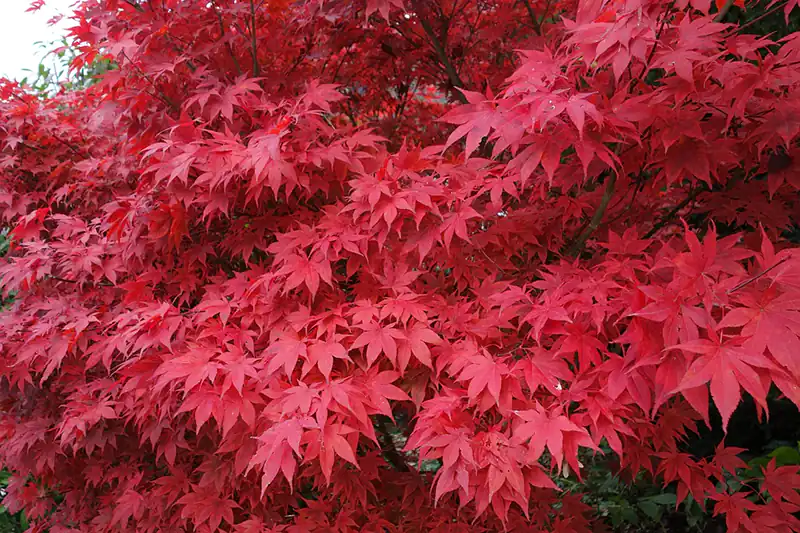
How To Care For A Japanese Maple Bonsai Tree
Welcome to our detailed section for the Japanese Maple bonsai. If the short overview above didn’t provide enough information, you could find everything you need right here. We’ll take you through every aspect you should assess when you buy one of these magnificent miniature trees.
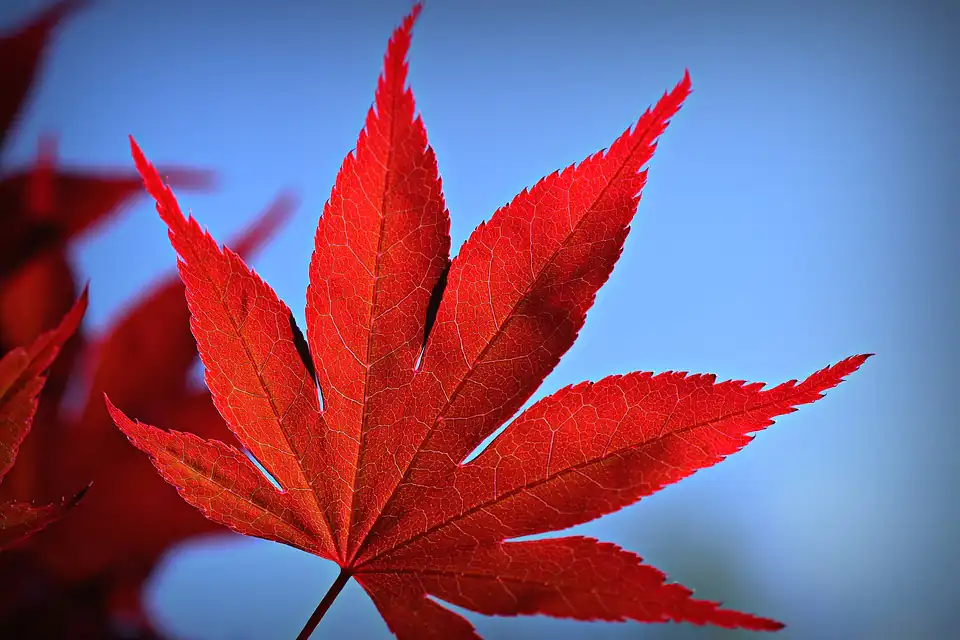
Light And Placement
If you want your Japanese Maple bonsai tree to survive, you need to place it in the right location. While it can grow well in nature, there are specific requirements for keeping it healthy in a pot. Here are the top questions pertaining to sunlight and location.
Can Japanese Maple Be Grown Indoors?
It’s entirely possible to grow a Japanese Maple bonsai inside your home. However, you’ll need to replicate the seasonal conditions. For instance, your tree will need sufficient sunlight during spring and summer, so place it near a sun-facing window for the morning.
You’ll also need to protect it from the cold and frost during the winter. Another consideration is how large Japanese Maple trees grow. You’ll need sufficient space for the foliage to expand, but you should prune it to adjust it to the available area around the leaves.
Can Japanese Maple Handle Full Sun?
How much sun your Japanese Maple bonsai can handle depends on the variety. Some of the maple trees can take between four to six hours of direct sunlight daily. Others develop leaf burn, especially when the sun hits the peak afternoon, so they’ll need partial shade.
The best way of handling this is to put it in a spot that absorbs sunlight in the morning while receiving shade for the rest of the day. You can use a shade cloth as a cover, or position it against a wall that only allows for morning light. Try not to move it in and out of the house during different times of the day, as regularly changing locations will confuse it.
What Japanese Maple Is Best For Shade?
The Crimson Queen variant of the Japanese Maple tree is ideal for shady locations. It holds its red leaves well, even through spring and summer, when you give it indirect sunlight inside your home. It also doesn’t stress too much if you can’t give it morning sun for at least four hours.
Another variant you can try is Ryusen. Also known as Dragon Spirit, the Japanee Maple loves to extend branches along with low structures or the ground. It’s perfect for growing by your house walls or in any shady location.
Where Should I Place My Japanese Maple Bonsai Tree At Home?
You need to perform research on the type of Japanese Maple tree you have. There are many variants that do well in low light, while others will need more indirect sunlight. Then again, you find some sub-species that need full sunlight for a few hours and will need to be positioned near a window.
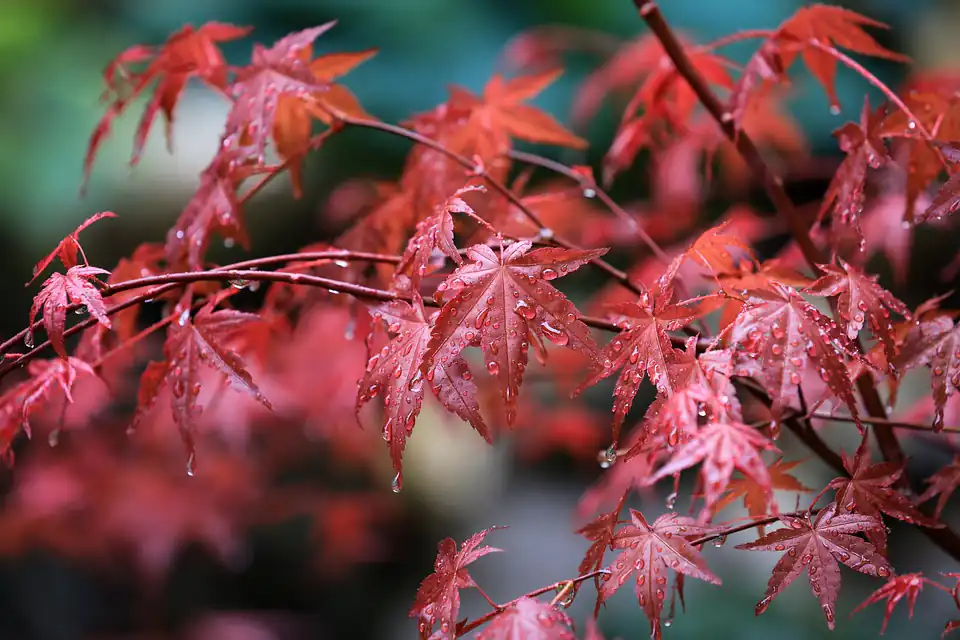
Watering
While you can get away with supplying only a bit of sunlight, the same can’t be said about water. Your Japanese Maple bonsai tree will be thirsty in the summer months, but you also need to ensure you don’t kill the roots. Here are some guidelines.
How Much Water Does A Japanese Maple Need?
When your Japanese Maple bonsai tree is young, it will need daily watering in the warm seasons. As they mature, you can bathe them in a tub of water about twice a week. They can handle drought conditions quite well, but it’s better to give them as much as they need.
In autumn and winter, you’ll need to reduce the frequency. If you drench the soil too often, it can lead to root rot and other fungal conditions in the soil. Wait until you see the bonsai tree needs water before you supply any.
How Do You Know When A Japanese Maple Needs Water?
In winter, there’s a good chance that winds will dry out the soil despite the cold. It still needs to drink in cold months despite the dormant period. The best well to tell if your Japanese Maple bonsai tree needs water is to check with your fingers or chopsticks.
Press your fingertip into the soil for the top 3 inches and see if you can feel any moisture. You need to differentiate between damp and moist. The cold weather can make it feel damp, but there may not be any liquid for the tree to absorb. With chopsticks, you’ll see wetness on the material when you draw it out of the soil.
Can You Overwater A Japanese Maple Tree?
A Japanese Maple tree doesn’t enjoy too much water, as it causes iron chlorosis. You may notice that the leaves change in appearance when this happens in the same way as underwatering. It can also cause root rot, which will eventually kill your tree. Check our guide for how to deal with Japanese Maple overwatering symptoms.
How Do I Know If My Japanese Maple Is Getting Too Much Water?
If you provide too much water, your Japanese Maple’s leaves will turn yellow. You may also notice some leaf burn in summer on your bonsai. The leaves and branches also become brittle and break easily, despite all the moisture.
The challenging part is that many of the symptoms are similar to what happens when you underwater your Japanese Maple bonsai tree. You’ll need to do the finger test to see how wet the soil is to determine if it’s a case of under- or overwatering. Either way, you’ll need to find a solution before it’s too late.
Can A Japanese Maple Recover From Overwatering?
You can still save your Japanese Maple bonsai from overwatering. Fungicides don’t help with root rot, so the best way to fix it is to replace the soil and allow for sufficient drainage. Give the roots a good clean before you put them back in the pot, and pay attention to how much water you provide.

Feeding, Potting, And Soil
In this section, we’ll look at everything you need to keep your Japanese Maple bonsai tree stable and well-fed. There are some requirements you need to be aware of in terms of soil type and when to repot it. We’ll also discuss how to maintain healthy roots for strong development.
What Is The Best Fertilizer For Japanese Maple Trees?
We recommend using a Japanese Maple fertilizer that’s low in nitrogen and high in phosphorus and potassium. In summer and spring, you can use a ratio of about 3:6:6 or similar. The reason is that slower growth develops thicker, stronger stems and branches. You don’t want it to shoot out too quickly or regularly.
If you’ve bought new soil for your Japanese Maple bonsai, don’t apply fertilizer until the second season. The nurseries usually supply soil mix with nutrients included, which should wash out when the next spring arrives.
When Should I Fertilize My Japanese Maple?
The best time to fertilize your Japanese Maple bonsai tree is in early spring when you see new growth. You can reduce the feeding during summer and autumn while stopping completely in winter when it goes into dormancy. Try to feed it as early in the morning as possible so that it can use the nutrients for the energy it needs during the afternoon.
How Do You Fertilize A Japanese Maple Tree?
There are two ways in which you can fertilize your Japanese Maple bonsai. The first is the liquid approach, which you’ll do about once to twice a month. You can also try solid pellets that usually last up to eight weeks, giving you less work over the seasons.
Remember to use as little nitrogen as possible if you want strong, healthy branches and leaves. Another approach you can use is to increase the nitrogen for one season to encourage fast growth and then less in the following seasons. As the tree matures, you won’t need to fertilize as much.
How Much Fertilizer Does A Japanese Maple Need?
The ratio of fertilizer you need for your Japanese Maple bonsai depends on your tree’s size. The general rule is 0.10 pounds nitrogen per 100 square feet. It also applies to every inch of trunk diameter. So you’ll need to take height, foliage width, and trunk girth into consideration.
From there, the NPK ratio will come into play. As you adjust for the nitrogen content, the phosphorous and potassium will follow naturally. The soil type will also play an essential role in how many nutrients are retained during the course of the season.
What Is The Best Mulch For Japanese Maples?
Mulch is essential for your Japanese Maple bonsai tree if you want to protect the roots from drying out in the summer. It also shields them from frost in winter. The ideal mulch materials are shredded hardwood bark or well-rinsed pistachio shells.
Layer the mulch evenly over the soil to ensure that it’s not exposed to the sun for too long. The water will evaporate and may burn any exposed roots. You can even develop stunning patterns to complement your bonsai.
What Kind Of Soil Do Japanese Maples Like?
Japanese Maple trees love soil that has a pH level between 5.5 and 6.5. It enjoys slightly acidic levels, hence why pistachio shells are ideal for mulching. However, make sure the sodium levels remain low, as it can harm the roots.
You should also ensure that the soil is high in organic matter. It can tolerate poor soil conditions, but only to a certain degree. Since the Japanese Maple bonsai grows slowly, it means increased stress if you keep it in poor conditions for too long.
Can Japanese Maple Grow In Clay Soil?
When it comes to soil, the roots of the Japanese Maple bonsai need space to breathe as well as decent drainage. Clay soil doesn’t allow for either of these, which means your tree may die. It may also cause root rot to form, causing more issues than you’d like. Steer clear of clay soil.
Is Peat Moss Good For Japanese Maples?
Peat moss works well for Japanese Maple trees in moderation. The ratio in a standard soil mixture should be 20% peat moss, 40% organic compost, and 40% fine sand. It will hold the nutrients in the soil while also providing ample drainage.
The peat moss can be placed as a top layer or in the middle to help retain moisture in the warmer seasons. If you already have mulch or other media for drainage, you don’t necessarily need to add peat moss to the equation.
Do Japanese Maples Have Invasive Roots?
The only time you would worry about invasive roots is if you have a weak container or plan to plant your bonsai in the ground for a few seasons. Fortunately, the Japanese Maple tree doesn’t extend the roots as wildly as the canopy, so they aren’t considered invasive.
You can safely plant a Japanese Maple tree a meter from your home or plumbing without worrying about it damaging any infrastructure. Your pot is also safe from any damage, as the roots are soft and slow-growing. For this reason, even a small container is perfect for bonsais.
Do Japanese Maples Have Deep Or Shallow Roots?
Japanese Maple roots don’t extend down and prefer to remain near the surface, extending outwards. Therefore, it has shallow roots. It’s best to buy a shallow pot for your bonsai so that it can reach the water in the soil or if you have a container. You should also invest in a humidity tray for the foliage.
If you purchase a deep container, your Japanese Maple bonsai will struggle to soak up the moisture from the lower parts of the pot. To remedy this situation, place small drainage rocks up to 40% of the height. You can then place your soil mixture above this.
How Often Should You Repot A Japanese Maple Bonsai?
When your Japanese Maple bonsai is young, you should repot it at least every year. The best time is at the end of winter when the temperature starts to rise and before the first buds appear. After the third season, you can switch to repotting every second year.
As soon as your bonsai is mature, you can expect the root development to slow down. If you see the roots don’t extend as far as they used to, you can transplant it every fourth year. Keep an eye on any roots showing through the drainage holes or the water struggling to escape.
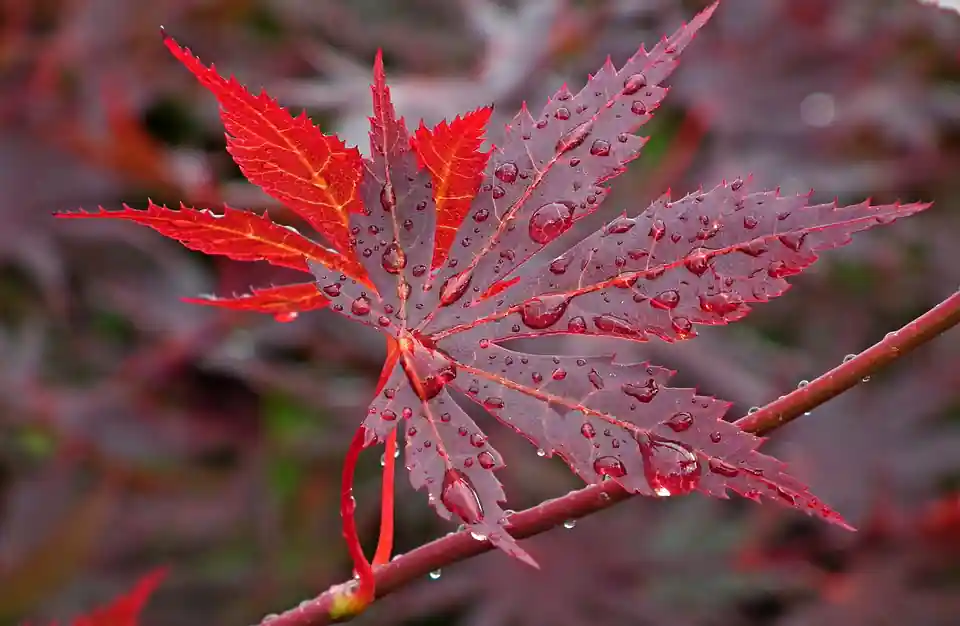
Structure And Foliage
To make your Japanese Maple bonsai look beautiful, you’ll need to focus on the bonsai’s structure and foliage. It involves caring for the leaves, branches, and flowers if you want to see seeds one day. Here are a few helpful tips.
What Does A Japanese Maple Tree Look Like?
Most Japanese Maple leaves are green that turn orange, brown, or red in the fall and winter. However, some variants are red all year long, while others may not change color at all. It has a thick trunk that develops a dense canopy of leaves, with branches that spread out evenly. Here is a guide for how to identify a Japanese Maple by leaf and other factors.
What Is The Leaf Shape Of A Japanese Maple?
The Japanese Maple leaf palmate or hand shape, and they’re oppositely arranged on the stem. Each leaf has about five to seven lobes, depending on the size and variant. On a standard tree, it can be anywhere between two to five inches long.
Why Are My Red Maple Leaves Turning Green?
When winter turns to spring and then summer, your Japanese Maple bonsai receives plenty of sunlight for most of the day. It causes your tree to create chlorophyll, which assists with making food for the cells. This component is the reason the maple leaves turn from red to green.
How Do I Make My Japanese Maple Red?
When summer turns to fall, the days are shorter and the nights become cooler. The Japanese Maple bonsai stops producing chlorophyll, which is when the leaves change from green to orange or red. It depends on how cold the winter becomes for the leaves to drop.
You can simulate this feature even when it’s not autumn. If you place your Japanese Maple bonsai outside in the shade of other trees, it won’t receive enough direct sunlight to produce chlorophyll. However, it depends on how cold the evenings are. Just remember that your small tree needs to make food to remain healthy.
Do Japanese Maple Trees Have Flowers?
Not only does the Japanese Maple bonsai have flowers, but it’s monoecious in nature. That means it develops the female and male flowers on the same tree. It’s easy to develop seeds due to this reason, as pollination animals don’t have to go far between the different components or search for other trees.
The flowers are tiny and inconspicuous, so they don’t attract insects like plants with massive blooms. Instead, you’ll usually find other creatures doing the work, such as squirrels looking for nuts, songbirds, quail, and grouse. That’s why you may need to assist with pollination when it comes to your Japanese Maple bonsai.
What Month Do Japanese Maples Bloom?
Japanese Maple bonsais usually bloom in late spring or early summer. The small flowers appear in the warmer months, and the seeds may form towards the end of summer or into early autumn. If you’re in the Northern Hemisphere, you should see the first flowers between May and June.
How Do You Take Care Of A Japanese Maple Flower?
The small flowers of the Japanese Maple tree are small and fragile. When the samara, or fruit, form, the wind usually assists with transporting the seeds to new locations. Before then, you should protect the blooms from strong winds that may break them.
It’s also ideal to have them in the morning sunlight for as long as possible. The flowers may still attract small pollinating insects that are checking your other bonsais for pollen. Spray a light mist to help with humidity and ensure it receives water daily.
Why Did My Japanese Maple Tree Not Bloom?
There could be a few reasons for your Japanese Maple bonsai not blooming. For one, some of the branches may have died during the winter, so there’s more of a focus on leaf and stem production. Secondly, it may be infected with Verticillium wilt that causes a blockage of sap in the branches.
If you don’t provide enough phosphorus or potassium in the soil, your bonsai tree might not have enough food to create flowers. You also need to make sure it receives enough sunlight in the morning for photosynthesis. It’s also a good idea to check for girdled roots, which can prevent leaves and flowers from forming.
What Do Japanese Maple Seeds Look Like?
Japanese Maple seeds are red with small wings attached to them. When they ripen, the color changes to brown. The wind transports them as they fly in the air to new locations. The seed has a hard outer core that’s hard to break through, so it will only germinate under the right conditions.
When the seeds fall, they look like small boomerangs spinning around. You should only harvest them when they are brown, as the red hue indicates that they aren’t ripe as yet. There’s less of a chance of getting them to germinate if you don’t collect them at the right time.
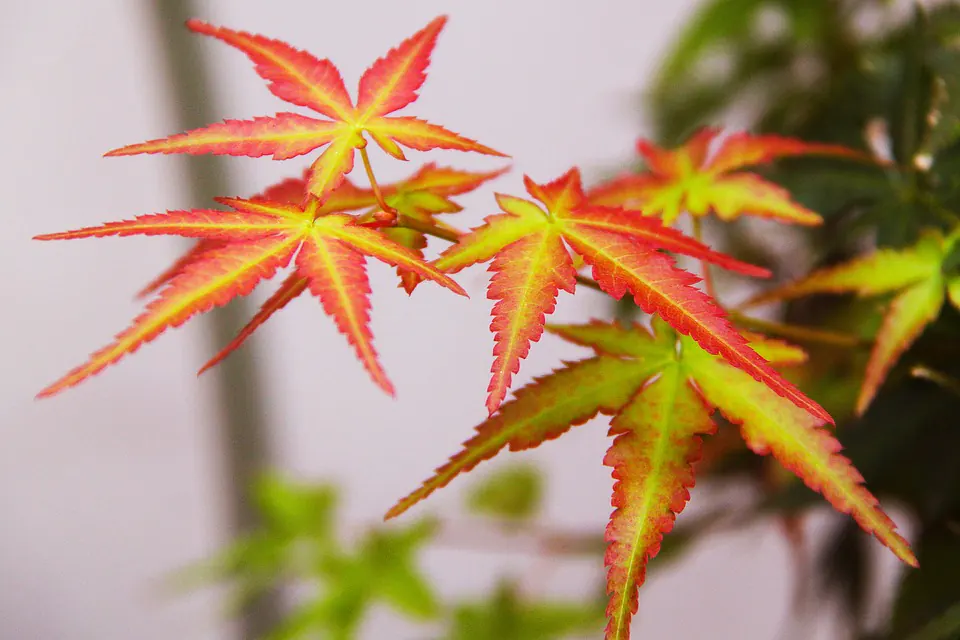
Maintenance And Cultivation
Next up, we’ll analyze the part you’ll play in maintaining the structure and health of your Japanese Maple bonsai tree. You can see how to prune and shape it, while we also discuss the various styles you can grow. Finally, you’ll see what other bonsai species look beautiful next to this one.
When Should A Japanese Maple Be Pruned?
There are three times in the year you’ll perform different types of pruning on your Japanese Maple bonsai. When it’s winter, you’ll want to do some design pruning when you can see more of the structure. Spring calls for finer trimming, making sure to keep your bonsai in shape as the new shoots appear. Late spring/ early autumn is ideal for defoliating.
How Do You Trim And Shape A Japanese Maple Tree?
It depends on the time of the year how much trimming you’ll do, which is not to be confused with pruning. The former is mild cutting or removing of small, weak sections, while the latter deals with reducing large components to maintain the style and shape of the tree.
No matter which part of the year, trimming a Japanese Maple tree follows the same process. All that differs is how much of it you perform. Here’s how to trim and shape your bonsai:
- Remove dead or frail leaves and branches on the inside of the foliage structure
- Don’t perform heavy shaping that causes holes in the foliage or canopy
- Don’t shear, as it will mess with the design and the natural drooping flow of leaves
- Cut cleanly back to the main stem or branch
- Disinfect before and after trimming to prevent the spread of any unseen diseases
Can A Japanese Maple Be Topped?
In some cases when a Japanese Maple bonsai has grown too high, many people resort to topping. They choose a spot on the main trunk and chop off a large portion of the top. Unfortunately, it can lead to diseases and infections, so it’s recommended that you perform crown reduction over time instead of reduction.
You should also steer clear of using any seals or wound dressings. The chances are that it will cause more harm than good, as the Japanese Maple tree has its own healing systems in place. Here’s how to perform crown reduction on your bonsai:
- Prepare your bonsai in early fall
- Remove dead sections
- Trim some of the upper branches where you see u-shaped angles by the connection to the main stem
- Reduce or remove only a few branches that are crossing others or extending beyond the desired shape or size
- Retain a pyramid shape in the crown as much as possible
Will Japanese Maple Grow Back?
Since the Japanese Maple tree is deciduous, you’ll notice your bonsai losing leaves in late fall into winter. When spring returns, you’ll see new buds and leaves growing back. If you don’t see any new growth into summer, the chances are that it has died, and you can remove it.
It’s always a good idea to inspect what the probable cause could be for your bonsai not growing back. Search for signs of infections or pests that may have eaten into the trunks. If you moved it inside for the winter and back outside for spring, it may just need some time to adjust.
How Do You Keep A Maple Tree Small?
As your Japanese Maple bonsai grows, you’ll need to trim branches and leaves to ensure they don’t grow too large. Massive leaves on your small tree can lead to too much evaporation of moisture. You can trim the canopy or remove smaller branches on the lower levels, causing each new growth to reduce in size.
What Complements Japanese Maple?
With so many variants of the Japanese Maple tree displaying gorgeous leaves and colors, it can be challenging to find other bonsais to complement them. However, there are a few species that will do incredibly well alongside them. It depends on your theme and the design you’re aiming for in the end.
Here are some bonsai tree ideas to consider to complement your Japanese Maple:
- Osmanthus fragrans (tea olive): tiny with fragrant flowers to match the maple’s leaves
- Ilex opaca (American holly): cascading green foliage
- Tsuga canadensis (hemlock) and Cryptomeria: stunning backdrops
- Malus sylvestris (crabapple) and Chionanthus virginicus (white fringetree): Beautiful blooms in spring
- Itea virginca ‘Henry’s Garnet’, (Virginia sweetspire) and Hydrangea quercifolia (oakleaf): adds red and burgundy leaves in fall to your maple collection
Which Are The Best Styles For Japanese Maple?
There are many Japanese Maple bonsai styles that people use . The most popular one is the formal upright with an umbrella canopy, as the foliage puts on a stunning display in the fall. You can also do any of the informal styles. Aiming for a forest with several canopies is absolutely beautiful and creates an effect seldom seen in bonsai nurseries.
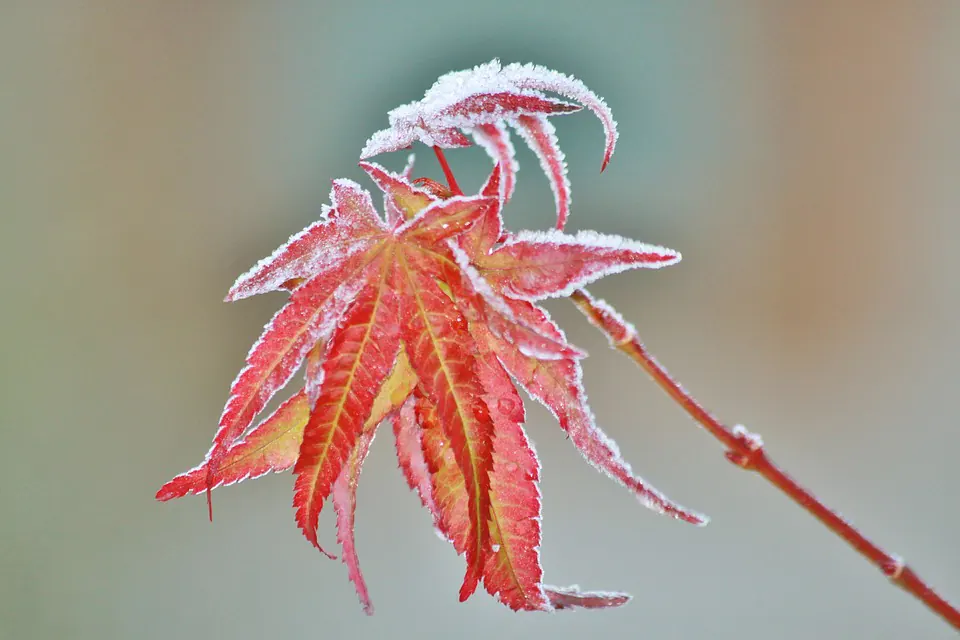
Wintering
As the Japanese Maple tree is deciduous, it will go dormant and rest in winter. Since it can’t take care of itself, it relies on you to make sure it’s looked after when the frost arrives. Here are a few helpful tips for what you should look out for.
What Do You Do With A Japanese Maple In The Winter?
Taking care of your Japanese Maple bonsai in the winter is essential if you want it to survive the season. Without any protection, the lowest temperature it can handle is -15° F, and not for too long. Ice and cold wind are two elements that may be the death of your small tree.
Here are steps you can take to protect your Japanese Maple bonsai in winter:
- Move it inside: While there are many ways you can defend your Japanese Maple outside, it’s better if you bring it inside. Even if there’s a wall to shelter against the wind, you still need to help with the cold. If you don’t have a greenhouse, bring your bonsai inside.
- Don’t feed your bonsai: When there are 2 months left before the first frost arrives, it’s time to stop fertilizing. Your Japanese Maple needs to go into dormancy and will store the food from autumn for winter.
- Bathe in water one last time: As autumn ends, give your bonsai one last soak. With the carbohydrates, it will store extra water for the cold months. You’ll hardly need to replenish the moisture, but check if the soil is dry with your finger anyway.
- Mulch insulation: Even inside your home, dampness and frost can damage the roots. It helps to place mulch on the soil’s surface, such as bark, dead leaves, shells, or wood chips.
Do Japanese Maple Trees Lose Their Leaves In The Winter?
The Japanese Maple tree is deciduous, which means it loses its leaves in winter. The fall is when you’ll see the leaves change color, depending on the variant or subspecies. When the leaves drop, it’s the best time of the year to admire and study the bonsai’s structure.
How Do You Prune A Japanese Maple Tree In The Winter?
In winter is when you’ll do some design pruning. You can work on the shape and structure, removing some of the internal branches that are overcrowding. Remember, most of the leaves will be on the outside of the canopy to absorb as much light as possible in spring and summer.
Should I Wrap My Japanese Maple For Winter?
In the wild, many people wrap Japanese Maple trees in burlap. It protects it from frost and animals trying to make a home in the wood. For a bonsai, it’s best to bring it indoors where it’s safe from both elements. If it’s cold in your home too, you can carefully wrap the trunk and large branches to keep it warm.
Are Japanese Maples Hardy?
The hardiness zones for the Japanese Maple tree are between 5 and 8. It doesn’t do too well with temperatures that are either too hot or cold. While it can sustain low climates, frost, ice, and severe cold winds can kill it with too much exposure.
How Do You Know When A Japanese Maple Is Dormant?
You’ll know when your small bonsai goes dormant as soon as the first leaves start to fall. If you’ve entered winter and your Japanese Maple still has autumn leaves, it means that the temperature hasn’t fallen low enough for dormancy. When the new buds appear in spring is when it’s breaking out of the resting period.
Will Frost Hurt My Japanese Maple?
A sign that frost may have harmed your Japanese Maple is when new leaves turn black or brown soon after forming in spring. They’ll regrow, but the branches and foliage may be weaker when they do. If any of the new buds are injured by frost, they’ll refuse to bloom and remain closed.

Propagation
Would you like to grow your own Japanese Maple bonsai without buying it? At Bonsai Alchemist, this act is our favorite part of developing these small trees. We’ll show you the various ways you can propagate them and how to care for them once they’re growing.
How Fast Do Japanese Maple Seedlings Grow?
Japanese Maple seedlings tend to grow incredibly slowly, reaching only 1 to 2 feet per year. When grown as a potential bonsai in a pot, the growth rate may be even slower depending on conditions. There are a few elements that can speed it up, such as fertilizer, plenty of sunlight, sufficient water, and warmth.
How Do You Take Care Of Maple Seedlings?
If you place your Japanese Maple seedling inside, you’ll protect it from most of the elements. However, it does enjoy plenty of sunlight, so extra care needs to be taken if you decide to put it outside.
Here are a few steps you can take to care of your maple seedling:
- Remove any weeds that form on the soil
- Place mulch on the soil to prevent future weeds
- Insert four stakes around the seedling to help it develop
- Wrap a wire mesh around and over the stakes
- Tie bird netting on the top of the mesh
- Keep the soil moist
Can You Grow Japanese Maple Cuttings In Water?
One of the best ways to propagate a Japanese Maple is to take cuttings and place them in water. You’ll need to cut at a 45° angle and put hormone powder on the tip. Remove any leaves on the lower end of the cutting, with only a few at the top to absorb sunlight. In time, those leaves may die as new buds form.
When Can You Take Japanese Maple Cuttings?
The best time for Japanese Maple cuttings is between late spring and mid-summer. You should aim for softwood that hasn’t hardened yet but is strong enough to stand in soil unsupported. Use peat moss and sand as the propagation medium, which works slightly better than putting it straight into the water.
How Do You Root A Japanese Maple Tree From A Cutting?
If you’re keen to take a cutting from a Japanese Maple tree to grow into a bonsai, you need to ensure you follow the correct steps. It’s best that you cut the heel of the branch so that a small part of the parent tree is included. Use rooting hormone on the tip and prepare the new soil. Once you have the new pot established, place a transparent bag around it to maintain humidity. You can also clone a Japanese Maple this way.
Can Japanese Maple Be Air Layered?
Another possible safer way to propagate a Japanese Maple tree is by air layering. You clean a portion of the trunk or a thick branch from bark and place hormone powder and sphagnum peat moss around the opening. With sheeting around it for a few months, and you should see new roots appear after a year.
Can You Graft A Japanese Maple To A Regular Maple?
The season, environment, temperature, and timing all have an impact on the success of grafting a Japanese Maple to a regular maple tree. You’ll need the latter as the rootstock, while the former is the scion you will graft to it. The best time to do so is in late winter before any new buds or growth forms.
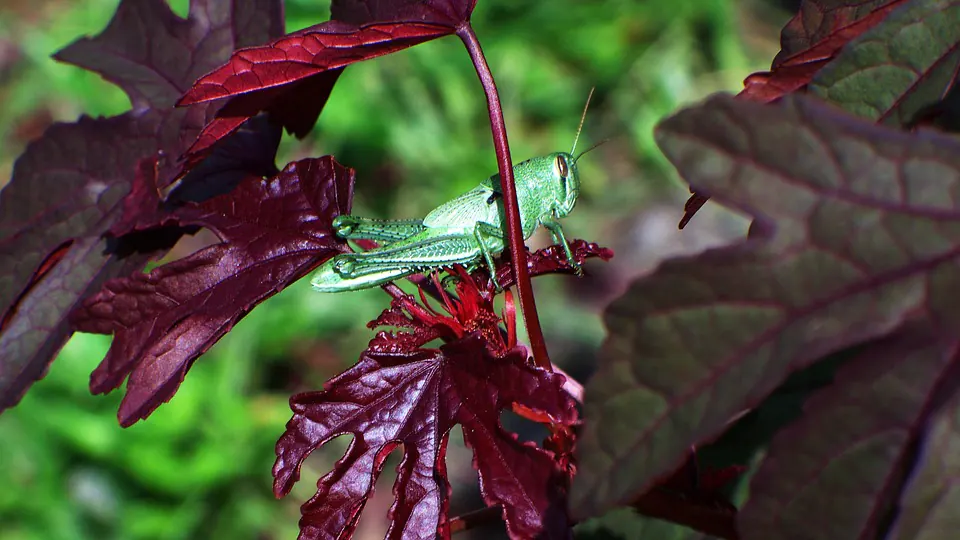
Pests And Diseases
The final part of caring for your Japanese Maple bonsai is watching out for pests and diseases. There are many small critters that would love to get their small teeth onto the leaves and sap. If you want to ensure its survival, you’ll need to take some steps to protect it.
What Does Fungus Look Like On A Japanese Maple?
There are different types of fungi you might find on a Japanese Maple bonsai, each with various appearances. For instance, mold can look like powdery mildew, while leaf spot presents circular discoloration. Another variation is anthracnose which shows small spotted circles over the leaf’s surface.
How Do You Treat Fungus On A Japanese Maple?
While you can buy fungicide from your local store, all it will do is prevent the spread of the disease. You’ll need to remove all infected leaves and branches and burn them in a compost pile. It’s the best way to ensure the survival of your Japanese Maple bonsai.
What Does Verticillium Wilt Look Like On Japanese Maple?
Verticillium wilt on a Japanese Maple makes your leaves look dried out, which eventually dies out. It’s not related to the dormancy period. The leaves also change color. Another indication is that the wood at the base of branches may have gray or green streaks. You’ll notice it spreading to other parts of your tree.
What Does Maple Blight Look Like?
You may notice powdery mildew on the Japanese Maple leaves, which then change in color before forming holes. There’s also blackness that can also spread to the stems holding them. It’s caused by plant tissue dying as the disease continues to eat at your bonsai.
What Does A Sick Maple Tree Look Like?
When a Japanese Maple bonsai is sick, there are many signs that will give you a hint. For instance, leaves may look scorched or there are strange formations on them. Streaks may appear on softwood, and you can cut open a branch to see if there’s any discoloration in the cambium or wood.
What Are The Bugs On My Maple Tree?
Sadly, the Japanese Maple bonsai is prey to many types of bugs. A common one you may find is the wooly alder aphid, which is fuzzy in appearance and drinks on sap. They grow in large colonies, which means they can spread quickly over your small tree. Other dangers you should watch out for are caterpillars.
How Do I Get Rid Of Japanese Maple Bugs?
Narrow-range oil, neem oil, and insecticidal soap are all good options for the Japanese Maple. You can spray or rub them over branches and leaves, making sure you cover all sides. Ensure you check all hidden areas, like the nodes between branches and the trunk, or between the leaves and stems. Dry your tree afterward so that the liquid doesn’t stain or burn the leaves.
Is Neem Oil Safe For Japanese Maple?
Neem oil is safe for use on your Japanese Maple bonsai, as long as you dilute the solution. We’ve seen many instances where using a strong application has harmed the small tree, so we recommend you try insecticidal soap instead. There’s less of a chance of your bonsai reacting negatively to it.
Why Are My Japanese Maple Leaves Curling?
There are many stress factors that can cause leaves to curl on your Japanese Maple bonsai. For example, insufficient water, high or low temperatures, sunburn, and pests are aspects to inspect. You’ll need to address any of these problems if you want to fix leaf curl.
Why Are Branches Dying On My Japanese Maple?
Some reasons branches may be dying on your Japanese Maple tree are extreme cold or heat, over- or underwatering, or too much fertilizer. In most cases, correcting these situations will see new life appear on the stems. If it’s during the dormancy period, bring your small bonsai indoors until the conditions improve.
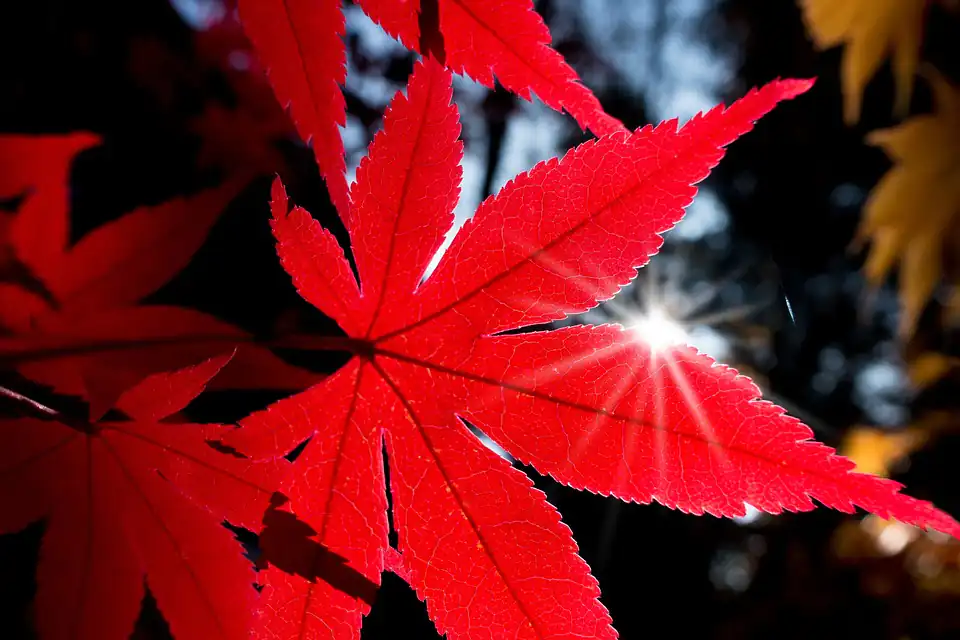
General Guide
Now that you’ve seen how to care for your Japanese Maple bonsai, here’s a general guide on a few extra pointers. This supplementary text discusses a few questions we found online, as well as showing you some variants that make stunning miniature trees. Finally, we’ll mention how long you can expect it to grow and what size it can reach.
How Many Japanese Maple Varieties Are There?
The Japanese Maple has been a popular bonsai for enthusiasts worldwide. It’s so marvelous, that it has spawned thousands of variants. Most of them have similar characteristics, but there’s something unique about each one of them to make them stand out.
Here are some of the top types of Japanese Maple treesthat we at Bonsai Alchemist love.
Bloodgood (Acer palmatum atropurpureum ‘Bloodgood’)
Prized for its magnificent purple-red leaves, the Bloodgood Japanese Maple has a stunning spread. If you place it in direct sunlight, the leaves tend to become slightly green, so it’s ideal for patios with indirect sunlight. The hardiness zone is 5 to 8, and it’s native to China, Japan, and Korea.
Coral Bark (Acer palmatum ‘Sango-kaku’)
As the name implies, the Coral Bark Japanese Maple is valued for its reddish bark. It grows slower than most of the other variants in this list, but it’s worth the wait. The yellow-green leaves become a stunning golden color in the fall. It has the same hardiness zone and native area as the Bloodgood variety.
Emperor (Acer palmatum ‘Emperor I’)
The Emperor Japanese Maple also has gorgeous purple-red leaves in spring and summer, becoming crimson in the fall. It loves moist soil, which can also prevent the leaves from becoming scorched in full sun. It’s a popular choice by bonsai enthusiasts since it needs little pruning.
Lion’s Head (Acer palmatum ‘Shishigashira’)
When you see the Lion’s Head Japanese Maple tree, you’ll understand the reason for its name. The leaves are mixed between green and yellow, while the foliage looks like a lion’s mane. It’s perfect for bonsai pots, and the leaves drop a bit later in the winter than with most variants. The hardiness zone is between 6 and 9.
Osakazuki (Acer palmatum ‘Osakazuki’)
The stunning Osakazuki Japanese Maple puts on a beautiful display for three seasons. While starting with green leaves, it shifts to scarlet orange in the summer and crimson red in autumn. It’s one of the variants with the highest resistance to leaf scorch. You should only prune it in its dormant period to prevent it from losing too much sap.
Purple Ghost (Acer palmatum ‘Purple Ghost’)
The one aspect that sets the Purple Ghost Japanese Maple apart from the others is the ruffled foliage. Even in spring, it retains the purple-red leaves that are so transparent you can see the veins clearly. In fall, they turn to crimson red. It can handle higher levels of heat as long as you water regularly.
Sherwood Flame (Acer palmatum ‘Sherwood Flame’)
When it comes to showing off, the Sherwood Flame Japanese Maple isn’t shy. It holds purple-red leaves throughout spring and summer, while softly fading to green in the fall before changing to crimson red. Even the stalks and samara seeds are red, which puts on a stunning display in bonsai nurseries where available.
Inaba-Shidare (Acer palmatum var. dissectum ‘Inaba Shidare’)
This Inaba-Shidare Japanese Maple tree is prized by gardeners worldwide for its beautiful contribution to stunning landscapes. It has gorgeous purple-red leaves that look romantic in appearance, changing to crimson red in the fall. The most outstanding features also include the strong upright trunk and sweeping branches.
Red Dragon (Acer palmatum var. dissectum ‘Red Dragon’)
A variant on the Inaba-Shidare, the Red Dragon Japanese Maple also has striking purple-red leaves, albeit it grows slightly slower. The foliage is more feathery, which is the primary difference between the two. While it becomes somewhat scarlet in fall, it tends to maintain the same color throughout three seasons.
Crimson Queen (Acer palmatum var. dissectum ‘Crimson Queen’)
Perhaps one of the most popular Japanese Maple variants, the Crimson Queen is usually found near streams and ponds where it dips its weeping branches in the water. It’s fond of dappled shade, which is why it’s an excellent choice as an indoor bonsai. Another reason is its tendency to grow as a dwarf tree, maintaining its small size easily.
Garnet (Acer palmatum var. dissectum ‘Garnet’)
Another one with red leaves for most seasons, the Garnet Japanese Maple showcases red-orange foliage in spring. The leaves are more thread-like than most of the standard ones, giving them a stunning appearance. As a bonsai, you’ll generally replicate the umbrella-mound style of the tree.
Tamuke-Yama (Acer palmatum var. dissectum ‘Tamukeyama’)
The Tamuke-Yama Japanese Maple is popular among Asian gardens and bonsai centers. It has a rich, dark purple-red color that brightens to crimson in the fall. As it’s slow-growing and loves partial shade, it takes to containers well. It prefers heat to cold.
Green Cascade (Acer palmatum ‘Green Cascade’)
The Green Cascade Japanese Maple has emerald leaves in spring, which becomes a soft orange in the fall. There are about 9 to 11 lobes per leaf, which gives the bonsai full foliage in the summer months. It can handle partial or full sun, as long as the peak afternoon light doesn’t burn the leaves.
Green Mist (Acer palmatum ‘Green Cascade’)
Popular for hedging, the Green Mist Japanese Maple tree has fine leaves with small lobes, which gives it a gorgeous appearance as a bonsai. There may be a slightly orange tinge to the leaf edges, while the tree changes to golden or bright orange in the fall. You should only prune in summer, as the sap may leak during other seasons.
Waterfall (Acer palmatum ‘Waterfall’)
The Waterfall Japanese Maple has stunning green cascading leaves that turn golden in autumn. It can handle hot climates incredibly well, as long as you provide sufficient water. Since it’s a low-growing tree, you can easily maintain it as a bonsai with the sweeping foliage.
Weeping Viridis (Acer palmatum ‘Virdis’)
Finally, we have the Weeping Viridis. This Japanese Maple has bright green leaves in spring, becoming golden in autumn with a touch of red or orange highlights. While it grows quite tall in nature, you can easily grow it in a bonsai container. It will complement other greens and yellows around it in your home.
The Scam Of The Blue Japanese Maple Bonsai
A few years ago, a scam artist used Photoshop in an attempt to sell a Blue Japanese Maple bonsai. Unfortunately, the tree doesn’t have that leaf color, and many people were tricked into buying seeds. When they germinated and grew, the leaves were green. This specific color doesn’t exist for the species.

Are Japanese Maples Hard To Grow?
The short answer to this question is yes, they can be hard to grow. The main reason is that they take so long to develop, and it requires a lot of patience. However, they’re also resilient and strong, which means they can withstand plenty of environmental conditions.
If you follow the steps in this care guide for the Japanese Maple bonsai, it shouldn’t be too difficult growing one. Of course, it depends on where you live and how much access it has to the required resources. Just do your best to avoid any form of stress.
Why Is The Japanese Maple Growth Rate So Slow?
The Japanese Maple spends its youth growing quite fast in comparison to when it reaches maturity. As soon as it settles in, the tree spends time expanding outwards rather than up. Also, pruning regularly tends to slow down the development of the branches and canopy. The roots also take time to grow.
What Is The Mature Size Of A Japanese Maple?
As you’ve seen, there are many variants of the Japanese Maple tree, each growing to its own size. On average, they develop between 12 and 25 feet high while the foliage spreads between 10 and 25 ft wide. Of course, a bonsai is as large as you let it grow.
While many Japanese Maples are of the dwarf variety, we do tend to like growing them taller than most bonsais. A good size is about 60 – 80 inches. You’ll need to prune and maintain the canopy to a girth that’s relative to the height if you want it to be symmetrical.
What Is The Average Japanese Maple Lifespan?
Most Japanese Maple trees reach full maturity at about 50 years of age, after which they stop growing as much as they used to. However, they can live for longer than 100 years if looked after properly. You may see the trunk and branches stop development, but the leaves will continue to form.
As a bonsai, you’ll want a Japanese Maple tree that’s older than 10 years. It will give you a good amount of time to watch it mature while also developing its shape. If you manage to get a bonsai over 50 years old, treasure it as much as possible. It may even be worthy to enter a museum.
What Does A Maple Tree Symbolize?
At one stage, Native Americans prized maple syrup as a source of food, which came to represent abundance and success. The Japanese Maple tree also symbolizes balance and offering, which is perfect as a bonsai gift to loved ones. It also means generosity, longevity, and intelligence.
The reason for longevity goes to how far back the Japanese Maple reaches into time. It’s believed that they existed during the time of the dinosaurs, joining legacies like Ginkgo Biloba. For this reason, the bonsai tree is revered among many bonsai societies.
What Are The Japanese Maple Medicinal Uses
It’s not just Japanese Maple trees that have medicinal properties, but the Acer genus as a whole. Maples have been responsible for treating many diseases in East Asia, while it’s also aided with illnesses in North America. It’s commonly known for assisting with the following:
- hepatic disorders
- rheumatism
- bruises
- Pain
- eye disease
- Detoxification

Japanese Maple Bonsai Inspiration
For the final section of our ultimate guide to the Japanese Maple, we would like to show you where you can find inspiration for your bonsai. We have some areas we’ve found online that you may like, while we also recommend where you can buy them.
Photo Inspiration For The Japanese Maple Bonsai
There are many online platforms that let you host photos of your Japanese Maple bonsai. Instagram and Pinterest are two that we enjoy using, but you can find many others with the same purpose. We’re putting together a list of the top Instagram accounts to follow for styling ideas, which we’ll post shortly.
Japanese Maple Tree Video Guides
Videos on caring for your Japanese Maple bonsai tree help to teach you the finer art of what we included in this article. We’ve seen many guides on platforms like YouTube that are incredibly helpful. And we’re not competitive enough to hide them from you. So, we’re also compiling a list of the top YouTube videos to check.
Books On Japanese Maple Bonsais
If you enjoy reading as much as we do, there are several ebooks and paperbacks that cover the Japanese Maple. In most cases, it will be in a generic book about bonsais with it listed as one of the species. However, there are a few that exclusively cover the topic.
Japanese Maple Bonsais For Sale
Since the species is prized so much worldwide, you’ll always find Japanese Maple bonsais for sale online and in your local store. They’re usually quite expensive due to the high demand for them. What we like to do is buy a small tree in a black bag for a really cheap price and then turn it into a bonsai.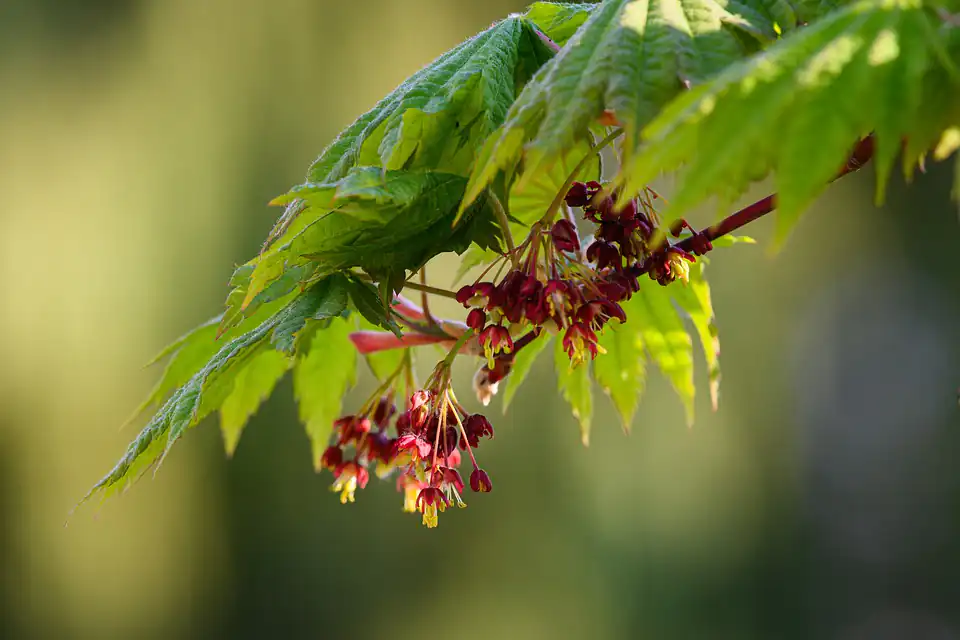
Final Thoughts
So, there you have it. Our exhaustive guide on the Japanese Maple bonsai tree is complete. If somehow we still missed something with all our articles and tips, please feel free to let us know. We’ll make sure to respond as soon as possible. You can also send us an email if you’d like a more personal touch.







